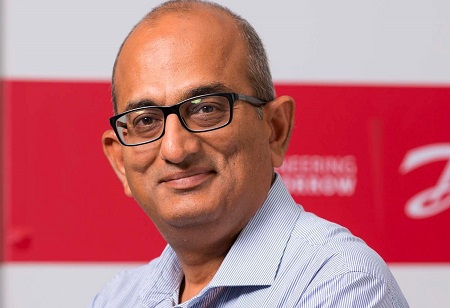
Ravichandran Purushothaman is the President of Danfoss India. He has been handling several roles since 2002 in Danfoss across several markets in Asia Pacific. He has been actively working in Energy, Water, Food & Agri, and Technology space supporting and mentoring several early-stage start-ups in India in various roles.
We spend an estimated 90 per cent of our time indoors, which means that buildings play a crucial role in our lives. However, buildings also contribute significantly to carbon emissions. According to the International Energy Agency, buildings account for approximately 40 percent of global energy consumption and 33 percent of carbon dioxide emissions. It is therefore crucial to make buildings more energy-efficient to reduce their carbon footprint and mitigate the impact of climate change.
The Importance of Energy-Efficient Buildings
Energy-efficient buildings can contribute to decarbonizing the built environment in several ways. Firstly, by reducing energy consumption, these buildings can help to reduce carbon emissions. Energy-efficient buildings can also promote a shift towards renewable energy sources. Additionally, these buildings can support the development of more sustainable cities and communities.
The potential impact of energy-efficient buildings is significant. According to the U.S. Green Building Council, buildings that meet its Leadership in Energy and Environmental Design (LEED) standards can use up to 25 per cent less energy and 11 per cent less water than conventional buildings. Additionally, these buildings can reduce greenhouse gas emissions by up to 34 per cent.
The Time to Act is Now
According to the EIA's International Energy Outlook, India will have the fastest growth in global commercial building energy consumption until 2040. (Energy Information Administration). The emissions in India will further peak due to economic growth, rising income levels, and population growth as there will also be an exponential demand for education, healthcare, leisure, recreation, and other services, resulting in the increased use of appliances and energy-consuming equipment for lighting, space cooling, and comfort.
This is an area for immediate action, investment, and policies to promote short and long-term energy security given India’s commitment to Net Zero transition. Energy efficiency (EE) is the fastest, easiest, and most impactful way to accelerate the green transition acknowledged by the world today.
Buildings as the Cornerstone to Decarbonization
Optimizing Energy Use
In terms of global energy consumption, the building stock represents a major portion. The building consumes 80 per cent of its energy for heating, ventilation, and cooling can result in an average energy savings of 30 per cent, with a payback time of two to four years.
Job Creation
A highly cost-effective platform for reducing GHG emissions, the building sector can also play an important role in creating jobs. For every million dollars invested in energy efficiency measures in the building sector, the IEA estimates that 9 to 30 jobs could be created. Across the entire energy sector, that is the highest potential. Moreover, these are local jobs that will spur the local economy as well as broader economic growth.
Health and Well-being
Energy-efficient buildings can also improve the health and well-being of occupants. Buildings that are well-insulated and ventilated can improve indoor air quality, reducing the risk of respiratory problems and other health issues. Additionally, energy-efficient buildings can also reduce noise pollution, improving the quality of life for those who live or work inside.
Addressing Energy Scarcity
By streamlining the deployment of smart technologies and energy-efficient products and services, households can save a significant amount on their final energy bill. It is estimated that EE can reduce around 40 per cent of India's emissions to reach the net zero target. It is crucial for India, which faces an energy shortage, to act quickly on energy in order to reach carbon neutrality. Smart use of energy can break the curve of energy demand. Moreover, each watt generated will be stretched further, easing the pressure on renewables.
Enabling Energy Efficiency Solutions in Buildings
The solutions are ready
There are four crucial trends driving zero carbon buildings: decarbonization, electrification, efficiency and digitalization. These four good “DEEDS” work in combination to reduce the carbon emissions and overall cost of building operations and supporting infrastructure. Despite this, some low-hanging fruit often goes unnoticed. To capture all the potential, that needs to change fast.
Decarbonization
The building can achieve zero carbon emissions if fossil fuels are avoided, renewable energy is used on and off-site, refrigerants with high global warming potential are reduced, and construction materials with low carbon are reused or recycled.
Energy Efficiency
Energy efficiency must remain a top priority for zero carbon buildings, even with a renewable energy supply. Energy efficiency investments save about two dollars in energy supply, whether they are made at the local, on-site level or at the grid level. The overall cost of grid infrastructure to meet future demand is also reduced.
Electrification
Global warming will increase electricity demand as previously moderate regions will need air conditioning to minimize heat stress. In warmer regions, unseasonably cold weather can also increase electricity demand. Building owners will incur higher costs as fossil energy prices (often subsidized) decrease and electricity infrastructure investment increases to expand generation, transmission, distribution, and management of increasingly intermittent renewable energy sources. As the HVAC industry continues to undergo digital transformation, advancements in monitoring instruments can enhance efficiency, performance, and sustainability.
Digitalization
Digitalization allows buildings to be more energy efficient and flexible in terms of demand. In "smart" buildings, advanced sensors, controls, data analytics, and energy optimization reduce energy usage and demand. Additionally, the use of digital capabilities in "smart" devices can improve reliability and allow remote management, while reducing energy consumption and emissions.
Investing in energy-efficient buildings is not only essential for reducing carbon emissions but also for promoting economic growth, improving health and well-being, and creating sustainable communities. It is time for building owners, policymakers, and other stakeholders to work together to accelerate the transition towards energy-efficient buildings and promote a more sustainable future for all.
We use cookies to ensure you get the best experience on our website. Read more...